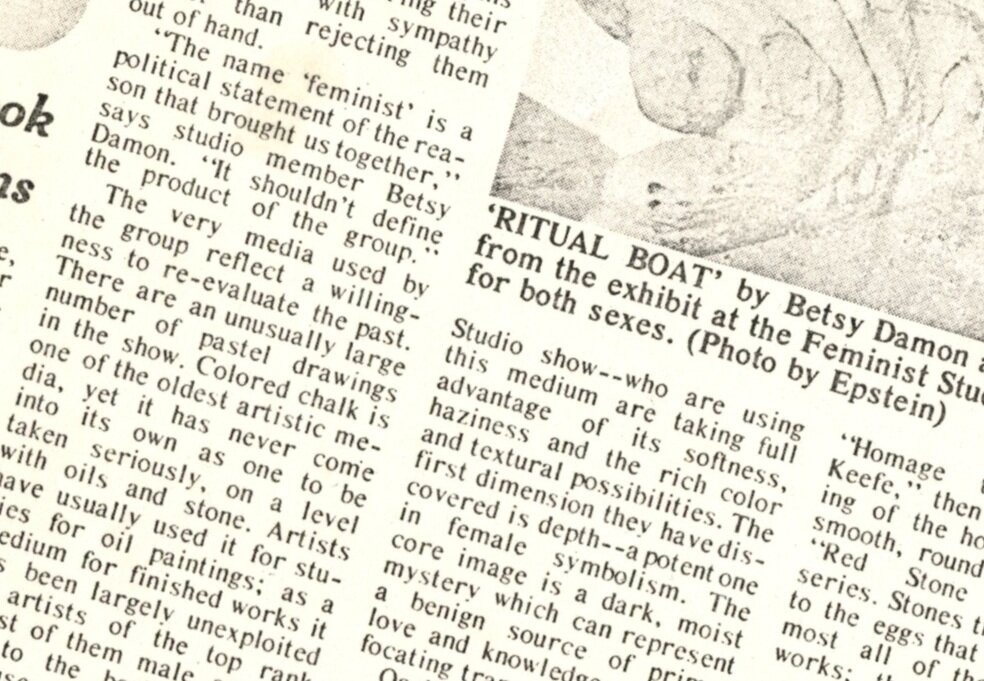
Press
Best Art Exhibitions of 2021
“This was the year when public awareness of ecocide reached at least an orange alert level. Direct response from museums and galleries remained muted, with [one of the] notable exceptions being … a survey of early work by the ecofeminist artist Betsy Damon at La MaMa Galleria in Manhattan.”
by Jillian Steinhauer, The New York Times
This was the year when public awareness of ecocide reached at least an orange alert level. Direct response from museums and galleries remained muted, with notable exceptions being “Diane Burko: Seeing Climate Change,” a solo exhibition of paintings at the Katzen Arts Center of American University in Washington (through Dec. 12); and a survey of early work by the ecofeminist artist Betsy Damon at La MaMa Galleria in Manhattan.
Art We Saw This Fall
“…radical relics of a time when many artists from oppressed groups were finding their voices through experimentation … almost like creative consciousness-raising.”
by Jillian Steinhauer, The New York Times
It can be hard to grasp the power of Damon’s pieces secondhand, but what comes through is her embrace of vulnerability and commitment to community. She opened herself up and challenged others to as well — and the photos suggest that she succeeded.
What to See in N.Y.C. Galleries Right Now
“…radical relics of a time when many artists from oppressed groups were finding their voices through experimentation … almost like creative consciousness-raising.”
by Jillian Steinhauer, The New York Times
It can be hard to grasp the power of Damon’s pieces secondhand, but what comes through is her embrace of vulnerability and commitment to community. She opened herself up and challenged others to as well — and the photos suggest that she succeeded.
As Galleries Reopen, Two Critics Find Rewards Eclipse the Angst
“[ecofeminism(s)] features 15 artists of different generations whose feminism is grounded in ecological concerns.”
Holland Cotter masks up on the Lower East Side and SoHo; Jillian Steinhauer discovers eco-feminist art taking root in Chelsea.
by By Holland Cotter and Jillian Steinhauer, The New York Times
The ambitious show (through July 24) features 15 artists of different generations whose feminism is grounded in ecological concerns. It includes important works that have been shown recently, like Agnes Denes’s “Rice/Tree/Burial” (1977-79/2020) and one of Ana Mendieta’s “Esculturas Rupestres (Rupestrian Sculptures)” (1981/2019), but widens our landscape of understanding with lesser-known, though no less impactful, historical works, like Aviva Rahmani’s “Physical Education” (1973), a Conceptual work centered on written instructions that outline a series of actions representing our disregard for the planet, and Betsy Damon’s “The Memory of Clean Water” (1985), a cast of a dry riverbed spilling down from the wall. The lineage extends to the present with Eliza Evans’s “All the Way to Hell” (2020-ongoing), a project in which she doles out the mineral rights to several acres of her land in Oklahoma to 1,000 people (you can buy in for $10) to prevent fossil fuel development.
Over the past few months, as I’ve been consumed by the pandemic and Black Lives Matter uprising, art has often looked marginal to me, at best. But “ecofeminism (s)” was one more visceral reminder that our world has been in crisis for centuries. As artists, writers, and humans, what choice do we have but to keep searching for points of connection and creative ways to respond?
Water Works: Living Waters of Larimer
“This “integrated rainwater catchment infrastructure” is another way to say ‘using every last drop’.”
by Keith Goetzman, Public Art Review • Issue 49
Rather than allowing the water to run off the plateau and disappear into the pipes and buried waterways of the Pittsburgh storm water system, Damon and Bingham aim to collect and divert it to wetland and irrigation demonstrations, to cisterns for use in gardens or businesses, perhaps to an aquaponics greenhouse or a water park. This “integrated rainwater catchment infrastructure” is another way to say “using every last drop”.
